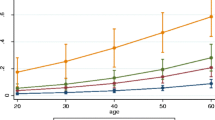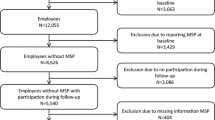Abstract
Aim: Musculoskeletal disorders (MSD) are a leading cause of work-related disability. This investigation explored the impact of MSD comorbid with depression and anxiety disorders, on labor force activity. Methods: The Australian Bureau of Statistics provided confidentialized data files collected from a household sample of 37,580 people. MSD, affective, and anxiety disorders were identified and employment restrictions were assessed at four levels of severity. Results: Anxiety and depression of six months duration was present in 12.1% of people with MSD. Comorbidity magnified the negative impacts of single conditions on labor force activity. Most at risk were people with back problems and comorbid depression, people with arthritis or other MSD and comorbid anxiety, males with MSD and comorbid depression, and females with MSD and comorbid anxiety. Conclusions: The results suggest that the occupational rehabilitation needs of people with MSD comorbid with depression or anxiety may currently be underestimated.
Similar content being viewed by others
References
Department of Employment and Workplace Relations. Characteristics of Disability Support Pension customers—June 2004. http://www.jobable.gov.au/DSPreport/2004/sec2.asp
European Communities. Work and health in the EU: A statistical portrait data 1994–2002. Office for Official Publications of the European Communities. Luxembourg: Panorama of the European Union.
Melhorn JM. Occupational orthopaedics in this millennium. Clin Orthop 2001;385:23–35.
Lerner D, Adler DA, Chang H, Lapitsky L, Hood MY, Perissinotto C, et al. Unemployment, job retention, and productivity loss among employees with depression. Psychiatr Serv 2004;55(12):1371–8.
Berndt ER, Finkelstein SN, Greenberg PE, Howland RH, Keith A. Workplace performance effects from chronic depression and its treatment. J Health Econ 1998;17:511–35.
Conti DJ, Burton WN. The economic impact of depression in a workplace. J Occup Environ Med 1994;36(9):983–8.
Schoenbaum M, Unutzer J, McCaffery D, Duan N, Sherbourne C, Wells KB. The effects of primary care depression treatment on patients’ clinical status and employment. Health Serv Res 2002;37(5):1145–58.
Waghorn G, Chant D. Labour force activity by people with depression and anxiety disorders: a population level second order analysis. Acta Psychiatr Scand 2005;112:415–24.
Waghorn G, Chant D. Employment restrictions among persons with ICD-10 anxiety disorders: characteristics from a population survey. J Anxiety Disord 2005;19:642–57.
Waghorn G, Chant D, White P, Whiteford H. Disability, employment and work performance among persons with ICD-10 anxiety disorders. Aust N Z J Psychiatr 2005;39:55–66.
Sullivan MJL, Feuerstein M, Gatchel R, Linton SJ, Pransky G. Integrating psychosocial and behavioral interventions to achieve optimal rehabilitation outcomes. J Occup Rehabil 2005;15:475–89.
Feuerstein M, Berkowitz SM, Haufler AJ, Lopez MS, Huang GD. Working with low back pain: workplace and individual psychosocial determinants of limited duty and lost time. Am J Ind Med 2001;40:627–38.
Feuerstein M, Harrington CB, Lopez M, Haufler A. How do job stress and ergonomic factors impact clinical visits in acute low back pain? A prospective study. J Occup Environ Med 2006; in press.
Shaw WS, Feuerstein M, Haufler AJ, Berkowitz SM, Lopez MS. Working with low back pain: problem solving orientation and function. Pain 2001;93:129–37.
Feuerstein M, Shaw WS, Lincoln AE, Miller VI, Wood PM. Clinical and workplace factors associated with a return to modified duty in work-related upper extremity disorders. Pain 2003;102:51–61.
Andrews G, Hall W, Teesson M, Henderson S. The Mental Health of Australians. National Survey of Mental health and Wellbeing. Report 2. Canberra: Commonwealth Department of Health and Aged Care, 1999.
Henderson S, Andrews G, Hall W. Australia's mental health: an overview of the general population survey. Aust N Z J Psychiatr 2000;33:197–205.
Kessler RC, McGonagh KA, Zhao S, Nelson CB, Hughes M, Eshleman S, Wittchen U, Kendler KS. Lifetime and 12-month prevalence of DSM-II-R psychiatric disorders in the United States. Arch Gen Psychiatr 1994;51:8–19.
Andrews G, Hunt C. Treatments that work in anxiety disorders. Med J Aust 1995;168:628–34.
Issakidis C, Sanderson K, Corry J, Andrews G, Lapsley H. Modeling the population cost-effectiveness of current and evidence based optimal treatment for anxiety disorders. Psychol Med 2004;34:19–35.
Australian Bureau of Statistics. Survey of disability, ageing and carers, Australia. Summary of findings, Cat. 4430.0. Canberra: Australian Government; 1998.
Australian Bureau of Statistics. Survey of Disability, Ageing and Carers, Australia. Technical Paper. Confidentialised Unit Record File. Canberra: Australian Government, 1998.
World Health Organization. International classification of diseases. 10th ed. (ICD-10). Geneva: World Health Organization; 1993.
World Health Organization. International classification of impairments, disabilities and handicaps. Geneva: World Health Organization; 1980.
SAS Institute. User's guide 8.02. Cary, NC: SAS Institute; 2003.
Kish L, Frankel MR. Balanced repeated replications for standard errors. J Am Stat Assoc 1970;65:1071–94.
Särndal CE, Swensson B, Wretman J. Model assisted survey sampling. New York: Springer-Verlag; 1992.
Waghorn G, Chant D, White P, Whiteford H. Delineating disability, labour force participation and employment restrictions among persons with psychosis. Acta Psychiatr Scand 2004;109:279–88.
Meijer EM, Sluiter JK, Frings-Dresen MHW. Evaluation of effective return-to-work treatment programs for sick-listed patients with non-specific musculoskeletal complaints: a systematic review. Int Arch Environ Health 2005;78:523–32.
Bond GR. Supported employment: evidence of an evidence-based practice. Psych Rehab J 2004;27:345–59.
Meltzer H, Gill B, Pettigrew M, Hinds K. OPCS Surveys of psychiatric morbidity in Great Britain. Report 1. The prevalence of psychiatric morbidity among adults living in private households. London: OPCS Social Surveys Division, HMSO; 1995.
Robins LN, Regier DA, editors. Psychiatric disorders in America: The epidemiological catchment area study. New York: The Free Press; 1991.
American Psychiatric Association. Diagnostic and statistical manual of mental disorders. 4th ed. Washington, DC: American Psychiatric Association; 1994.
Author information
Authors and Affiliations
Corresponding author
Rights and permissions
About this article
Cite this article
Waghorn, G., Chant, D. & Lloyd, C. Labor force activity among Australians with musculoskeletal disorders comorbid with depression and anxiety disorders. J Occup Rehabil 16, 235–246 (2006). https://doi.org/10.1007/s10926-006-9018-3
Published:
Issue Date:
DOI: https://doi.org/10.1007/s10926-006-9018-3




